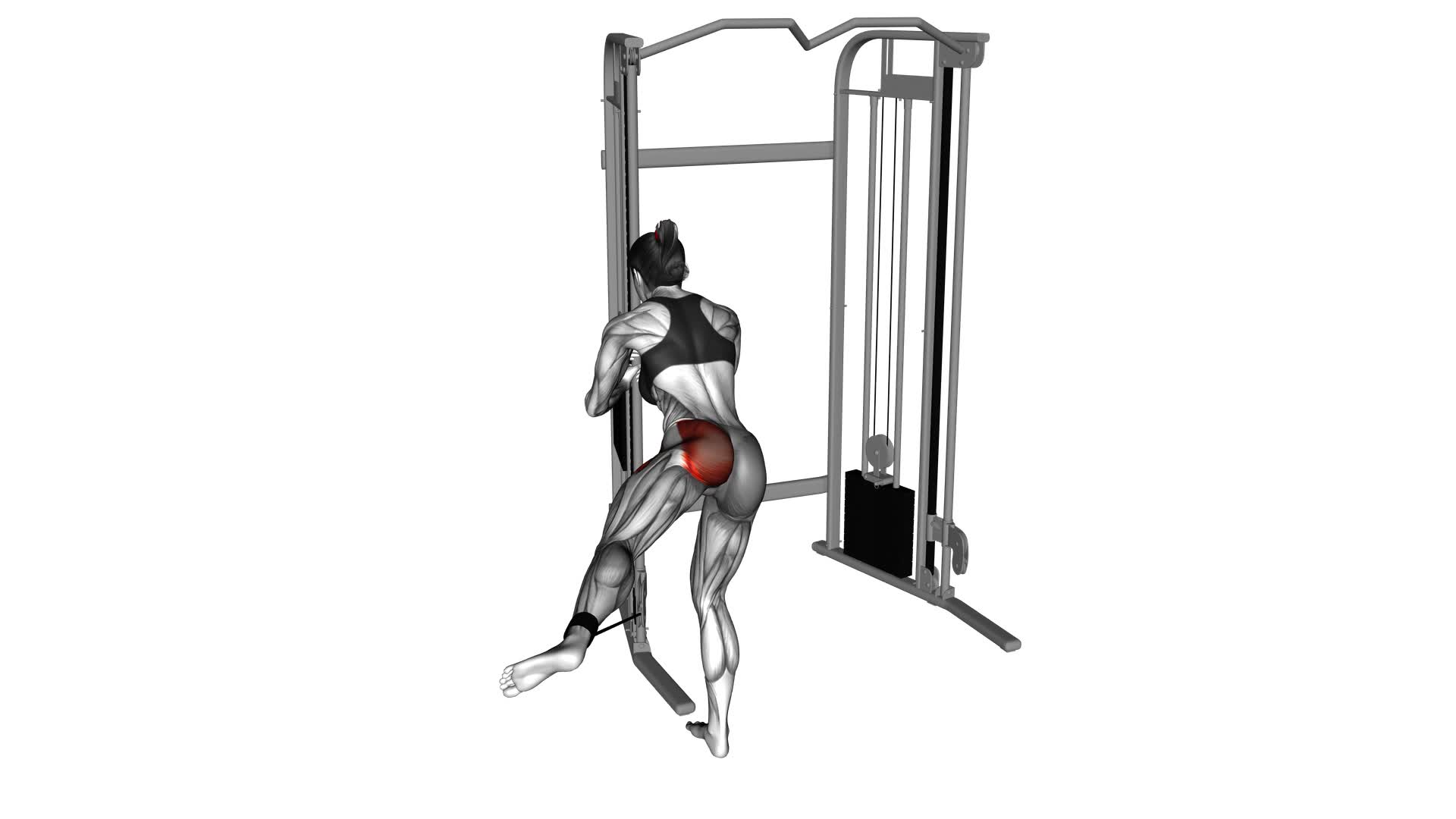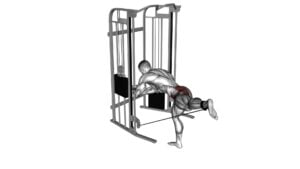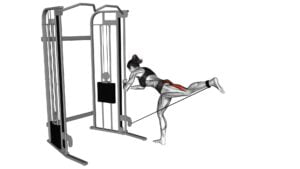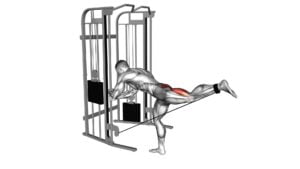Cable Donkey Diagonal Kickback (female) – Video Exercise Guide & Tips

Get ready to level up your workout with the Cable Donkey Diagonal Kickback! This exercise is perfect for targeting your glutes and transforming your lower body.
Watch This Exercise Video
In this video exercise guide, you'll learn the proper form, technique, and variations to maximize your results.
Don't miss out on this effective and efficient workout. Let's kick it into gear and achieve those fitness goals together!
Key Takeaways
- Cable Donkey Diagonal Kickback targets multiple muscle groups simultaneously, including the glutes, hamstrings, and core muscles.
- This exercise improves coordination, balance, and overall stability.
- It reduces the risk of injury when performed with proper form and technique.
- To maximize results, it is important to gradually increase intensity, incorporate recovery techniques, and fuel the body with a balanced diet.
Benefits of Cable Donkey Diagonal Kickback
One key benefit of the Cable Donkey Diagonal Kickback exercise is that it targets multiple muscle groups simultaneously, providing a highly effective full-body workout. The muscle activation achieved with this exercise is exceptional, as it engages the glutes, hamstrings, and core muscles. As you perform the kickback movement, your glutes are activated to extend the hip, while your hamstrings work to control the movement and maintain stability. Additionally, the core muscles are engaged to maintain a stable and upright posture throughout the exercise.
Not only does the Cable Donkey Diagonal Kickback target multiple muscle groups, but it also helps in gaining stability. By working on the glutes, hamstrings, and core muscles, you not only strengthen these muscles but also improve their coordination and balance. This is particularly beneficial for athletes or individuals involved in activities that require stability, such as running, jumping, or playing sports. The exercise challenges these muscles to work together, enhancing overall stability and reducing the risk of injury.
Equipment and Setup
To set up for the Cable Donkey Diagonal Kickback exercise, gather the necessary equipment and position yourself in front of the cable machine. This exercise requires a cable machine with a low pulley attachment and an ankle strap. Attach the ankle strap to the cable machine and adjust the weight to a challenging but manageable level.
Stand facing away from the machine with your feet hip-width apart. Place the ankle strap around your right ankle and step back, creating tension on the cable. Keep your core engaged and maintain a slight bend in your standing leg.
With your right leg, kick back diagonally behind you, extending your leg fully and squeezing your glutes at the top of the movement. Keep your upper body stable and avoid leaning forward. Control the movement as you bring your leg back to the starting position.
For variations of the Cable Donkey Diagonal Kickback, you can try using different foot positions, such as turning your toes out or in, to target different areas of your glutes. You can also experiment with different tempos, such as slowing down the movement or adding pulses at the top of the kickback, to make the exercise more challenging.
Incorporating effective cable donkey diagonal kickback exercises into your workout routine can help strengthen and tone your glutes, hamstrings, and core. Remember to always start with a weight that's appropriate for your fitness level and gradually increase the weight as you become stronger.
Proper Form and Technique
To perform the Cable Donkey Diagonal Kickback exercise effectively, it's crucial to focus on proper form and technique. Maintaining proper alignment throughout the movement is key to target the correct muscles and avoid strain or injury.
Importance of Alignment
Maintain proper alignment to maximize the effectiveness of your Cable Donkey Diagonal Kickback (female) exercise. Alignment plays a crucial role in various aspects of fitness, including yoga and posture. When your body is in proper alignment, you engage the correct muscles, reduce the risk of injury, and enhance your overall performance.
In the Cable Donkey Diagonal Kickback (female) exercise, alignment is key to target the glute muscles effectively. Start by standing tall with your feet hip-width apart and your core engaged. As you kick back diagonally, keep your hips square and avoid arching or rounding your back. Focus on maintaining a neutral spine and extending your leg with control.
Common Mistakes to Avoid
To maximize the effectiveness of your Cable Donkey Diagonal Kickback (female) exercise, it's important to be aware of common mistakes to avoid in terms of proper form and technique.
One common mistake is using too much weight, which can compromise your form and increase the risk of injury. It's crucial to start with a weight that allows you to maintain proper form throughout the exercise.
Another mistake to avoid is lifting your leg too high or too fast. This can cause your body to lose stability and decrease the effectiveness of the exercise. Instead, focus on controlled and deliberate movements, keeping your leg parallel to the ground.
Pay attention to your core engagement and avoid arching your back.
By avoiding these common mistakes and maintaining proper form and technique, you can ensure that you get the most out of your Cable Donkey Diagonal Kickback (female) exercise.
Now let's explore the benefits of correct technique.
Benefits of Correct Technique
You can experience significant improvements in muscle activation and overall effectiveness when you implement proper form and technique in your Cable Donkey Diagonal Kickback (female) exercise. One of the common misconceptions is that the exercise is solely focused on the glutes. However, by using correct technique, you can also engage the hamstrings, quadriceps, and core muscles.
Proper form ensures that the targeted muscles are being activated to their fullest potential, leading to better results. By maintaining a neutral spine, keeping the core engaged, and using controlled movements, you can optimize muscle activation and minimize the risk of injury.
Correct technique also helps in maintaining proper alignment, which is crucial for maximizing the benefits of the exercise. So, remember to focus on your form and technique to reap the full benefits of the Cable Donkey Diagonal Kickback (female) exercise.
Variations and Progressions
Start with a slight bend in your knees and position yourself facing the cable machine. The Cable Donkey Diagonal Kickback exercise has variations and progressions that can help you modify the movement to suit your fitness level and goals.
One variation of this exercise is to use different attachments on the cable machine. Instead of using the ankle strap, you can try using a handle attachment. This will change the angle of the movement and target your glutes and hamstrings in a slightly different way.
Another variation is to change the position of your body. Instead of facing the cable machine, you can stand with your side facing the machine. This will shift the emphasis to your outer glutes and hips.
To progress this exercise, you can increase the resistance by adding more weight to the cable machine. You can also try performing the exercise on a stability ball or a Bosu ball to challenge your balance and core stability.
Remember to always listen to your body and choose variations and progressions that are appropriate for your fitness level. It's important to maintain proper form and technique throughout the exercise to avoid injury and get the most out of your workout.
Common Mistakes to Avoid
One common mistake to avoid when performing the Cable Donkey Diagonal Kickback exercise is improper alignment of the hips. It's important to maintain proper alignment throughout the movement to effectively target the glutes and avoid any unnecessary strain or injury.
Here are some common mistakes to avoid and tips to ensure proper alignment:
- Avoid arching your back: Keep your spine neutral throughout the exercise. Avoid arching your back excessively, as this can put pressure on the lower back and compromise the effectiveness of the exercise.
- Do not let your hips rotate: Keep your hips square and facing forward throughout the movement. Rotating the hips can take the focus away from the glutes and engage other muscles instead.
- Avoid lifting the leg too high: Lift your leg in a controlled manner, focusing on squeezing the glutes at the top of the movement. Lifting the leg too high can lead to improper alignment and reduce the effectiveness of the exercise.
By avoiding these common mistakes and maintaining proper alignment, you can maximize the benefits of the Cable Donkey Diagonal Kickback exercise and achieve optimal results for your glutes.
Remember to listen to your body, start with lighter weights, and gradually increase the intensity as you become more comfortable with the exercise.
Tips for Maximizing Results
To maximize your results with the Cable Donkey Diagonal Kickback exercise, focus on maintaining proper form and gradually increasing the intensity.
First and foremost, it's crucial to ensure that your body is in the correct position throughout the exercise. Keep your core engaged, shoulders down and back, and maintain a straight line from your head to your heels. This will help target the glutes and hamstrings effectively.
To maximize intensity, you can start by using lighter weights and gradually increase the resistance as your strength improves. It's important to challenge yourself but also listen to your body. Push yourself, but not to the point of pain or discomfort. Additionally, vary the speed and tempo of the exercise to keep your muscles guessing and prevent plateaus.
In order to maximize your results, it's also important to incorporate recovery techniques into your routine. This includes proper warm-up and cool-down stretches, as well as allowing your body enough time to rest and recover between workouts. Additionally, make sure to fuel your body with a balanced diet and stay hydrated to support muscle growth and repair.
Frequently Asked Questions
How Many Sets and Reps Should I Do for Cable Donkey Diagonal Kickback to See Results?
To see results from the cable donkey diagonal kickback, you need to consider the number of sets and reps. Start with 3 sets of 12-15 reps for each leg.
This exercise targets your glutes and hamstrings, so make sure to maintain proper form throughout. Keep your core engaged and focus on squeezing your glutes at the top of the movement.
Can Cable Donkey Diagonal Kickback Help Me Build Muscle in My Glutes and Hamstrings?
To build muscle in your glutes and hamstrings, cable donkey diagonal kickbacks can be an effective exercise. Compared to other glute exercises, this move targets those specific muscles with precision.
Incorporating cable exercises into your workout routine offers unique benefits, such as constant tension on the muscles and the ability to adjust resistance.
Is It Necessary to Use a Cable Machine for This Exercise, or Can I Use Resistance Bands Instead?
You may be wondering if you can use resistance bands instead of a cable machine for the cable donkey diagonal kickback exercise. Well, the answer is yes! Resistance bands can be a great alternative to cable machines for glute exercises.
They provide similar resistance and can help you build muscle in your glutes and hamstrings.
To modify this exercise for different fitness levels, you can adjust the tension of the resistance bands or choose bands with different levels of resistance.
Are There Any Modifications or Alternative Exercises for Cable Donkey Diagonal Kickback if I Have Limited Mobility or an Injury?
If you have limited mobility or an injury, there are modifications and alternative exercises you can try for the cable donkey diagonal kickback. These modifications can help accommodate your specific needs and ensure a safe and effective workout.
How Often Should I Incorporate Cable Donkey Diagonal Kickback Into My Workout Routine to Get the Best Results?
To get the best results, it's important to incorporate cable donkey diagonal kickback into your workout routine regularly. This exercise targets your glutes and hamstrings, helping to strengthen and tone those muscles.
By including cable exercises like this one, you can add variety to your workouts and challenge your muscles in new ways.
To maximize the effectiveness of the cable donkey diagonal kickback, focus on maintaining proper form, using an appropriate weight, and gradually increasing the intensity over time.
Conclusion
In conclusion, the cable donkey diagonal kickback is a highly effective exercise for targeting the glutes and hamstrings.
By using the proper equipment and maintaining proper form and technique, you can maximize your results and avoid common mistakes.
With variations and progressions, you can continue to challenge yourself and make progress.
Remember to follow these tips and guidelines for a safe and effective workout.

Author
Years ago, the spark of my life’s passion ignited in my mind the moment I stepped into the local gym for the first time. The inaugural bead of perspiration, the initial endeavor, the very first surge of endorphins, and a sense of pride that washed over me post-workout marked the beginning of my deep-seated interest in strength sports, fitness, and sports nutrition. This very curiosity blossomed rapidly into a profound fascination, propelling me to earn a Master’s degree in Physical Education from the Academy of Physical Education in Krakow, followed by a Sports Manager diploma from the Jagiellonian University. My journey of growth led me to gain more specialized qualifications, such as being a certified personal trainer with a focus on sports dietetics, a lifeguard, and an instructor for wellness and corrective gymnastics. Theoretical knowledge paired seamlessly with practical experience, reinforcing my belief that the transformation of individuals under my guidance was also a reflection of my personal growth. This belief holds true even today. Each day, I strive to push the boundaries and explore new realms. These realms gently elevate me to greater heights. The unique combination of passion for my field and the continuous quest for growth fuels my drive to break new ground.







